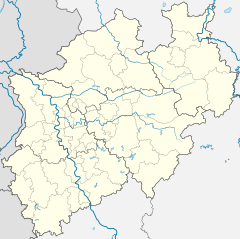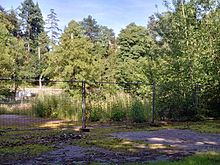Solingen-Graefrath station
| Solingen-Graefrath | ||
|---|---|---|
|
|
||
| Data | ||
| Design | Through station | |
| abbreviation | KSG | |
| opening | 1887 | |
| Conveyance | 1989 | |
| location | ||
| City / municipality | Solingen | |
| Place / district | Graefrath | |
| country | North Rhine-Westphalia | |
| Country | Germany | |
| Coordinates | 51 ° 12 '18 " N , 7 ° 4' 22" E | |
| Height ( SO ) | 220 m above sea level NHN | |
| Railway lines | ||
| Railway stations in North Rhine-Westphalia | ||
The Solingen-Gräfrath station was a station in the Solingen district of Gräfrath , which was on the disused railway line Solingen-Wuppertal-Vohwinkel .
history
prehistory
Gräfrath that as freedom since the beginning of the 15th century self-government had been in 1807 for mayor raised, in turn, in 1856 the city right after the Rhenish order received. From the second half of the 19th century, larger factories developed in the outskirts of Gräfrath, for example on the Foche , on the Central or on the Oben- and Unterflachsberg , which found no place in the densely built-up town center of Gräfrath. Just like Wald , Gräfrath also had to wait a long time for its own railway connection , which was to further accelerate the industrial development of Gräfrath.
Opening of the train station
After the nationalization of the nominally private railway companies, the Prussian State Railways decided to connect the cities of Solingen and Vohwinkel across the Bergisches Land . The first construction phase was to connect the Vohwinkel train station to the forest via Gräfrath . Coming from Fürkeltrath , the railway ran south-east past the town center of Graefrath and then in a long left curve over Dyck , Unterflachsberg , Focher Dahl to Apfelbaum and from there to Wald.
Initial plans envisaged the location further north at the Bandesmühle as the location for the train station . Against this, however, a citizens' committee fought back, so that finally the location further south on the then Freiheitstrasse / Solinger Strasse (today Wuppertaler Strasse) was chosen. In order for the station to be built there, however, the course of the street had to be changed, which originally led from Bergerbrühl in a straight line into the old town. To make room, the street was led in a left-hand curve over the tracks . At the level of the station building, the street met its old course again.
In the run-up to the opening of the station, naming it also turned out to be more difficult than initially assumed. In 1886 the town councilors of Gräfrath discussed numerous alternatives, such as Bergisch-Gräfrath , Gräfrath-Solingen and even Gräfrath-Elberfeld , in order to prevent confusion with place names of the same name. Finally, they agreed on the simple name Graefrath, but added the addition of Kr. Solingen .
The erection of a reception building caused some heated discussions . For cost reasons, it was not considered a once from the Rheinische Eisenbahn in Opladen to built building by Gräfrath translocate because this was no longer needed in Opladen. However, the responsible ministry put a stop to this unusual approach:
“It is not advisable to use the reception building that has become available at Opladen (Rheinisch) station at Gräfrath station, as it would have to undergo extensive changes due to (...) the different layout arrangement. (...) Another draft for the station building must be drawn up and submitted for the Graefrath station, unless it is preferred to use the approved draft prepared for the Wald station or its mirror image. "
As a result, in the end the decision was made to create their own design for a simply designed reception building, which was built in 1887 under the influence of the Swiss country house style and the Bergisch style . The construction costs amounted to around 35,000 marks . Overall, the station was thus also the smallest on the entire route, as it only had a few freight train tracks and two tracks for passenger traffic, one for each direction. Track I on the house platform was used for passenger traffic in the direction of Vohwinkel, the intermediate platform on track II was 109 meters long for passenger traffic in the direction of Wald and Solingen.
On November 15, 1887, the first passenger train ran the new route between Vohwinkel and Wald via Gräfrath. Only after the completion of the line between Solingen and Wald on February 12, 1890 did the so-called corkscrew railway, however, reach its full length after its winding course.
Years of operation
Despite its small size, the station brought considerable advantages for the Graefrath economy. The city grew rapidly, especially on its outskirts, where large factories like Dr. Hillers settled down. The industrial boom was accompanied by a sharp increase in population.
In contrast to other stations of the corkscrew railway, the Gräfrath station has hardly been expanded in the years of its operation. This was due to the fact that the property was encircled between the park cemetery and Wuppertaler Straße and hardly offered any opportunities for expansion. However, minor modifications took place. In 1898, for example, the station received a separate entry track for freight traffic to and from Vohwinkel in addition to track II. A weighbridge had already been installed beforehand so that freight traffic could be processed more quickly. However, there was never a signal box in Gräfrath, all points and signals were controlled from the dispatcher's room. This was attached to the station building.
There were some private connections around Graefrath station. In 1893, the Flachsberg brickworks received a direct rail connection to its new ring kiln. The Engels hub factory (Pränafa) owned two sidings, one in each direction. These tracks were also used by other businesses. The last private connections were the companies Schürhoff (scrap) and Nuhsbaum (waste paper recycling).
Shutdown and demolition
Passenger traffic was officially stopped on November 2, 1942. However, special passenger trains followed years later. After the Second World War , a shipping company used the old goods shed as a warehouse, and parts of the reception building were rented out as living space. After handling volumes continued to decline, goods handling was closed on May 21, 1966. With the closure of the wagonload tariff point Solingen-Gräfrath on May 31, 1989, the Gräfrath station was finally closed. However, the building was initially still used by a forwarding company. The last tracks were dismantled by the end of 1996.
In the course of the Regionale 2006 , the route of the former railway line was converted into a railway cycle path , the corkscrew route . The area around the old Graefrath train station was built in the third construction phase from Carl-Russ-Strasse to Graefrath train station by September 2006.
The station building and the attached goods shed were entered on June 9, 1988 as number 272 in the Solingen monument list. In September 1999 it was acquired by the Solingen industrialist Siegfried Lapawa. This would leave the now verfallenene building abort already in 2007, because in his eyes because of the parlous state and the mold infestation is a rehabilitation have not expected. The city of Solingen took the position that the train station would continue to have a monumental value and should therefore be preserved. Lapawa finally took legal action against the decision of the Lower Monument Authority. An appraisal was commissioned which attested to the station that in the event of a renovation only 10 percent of the original building stock could have been saved. The Düsseldorf Administrative Court then decided on November 5, 2010 that the city of Solingen had to remove the building from the list of monuments and that Lapawa had to grant the demolition permit. The demolition work began in late September 2011 and was completed in October 2011. Today the site is fallow, various usage concepts, such as the establishment of a full-range store, are still waiting to be implemented.
literature
- Kurt Kaiß, Michael Zimmermann: The corkscrew railway - on branch lines from Solingen to Vohwinkel , Rheinisch-Bergische Eisenbahngeschichte Volume 2, Verlag A. Kaiß, Leichlingen 1998; ISBN 3-9806103-0-6
Web links
swell
- ↑ a b c d e Kurt Kaiß, Michael Zimmermann: The corkscrew railway - On branch lines from Solingen to Vohwinkel , Rheinisch-Bergische Eisenbahngeschichte Volume 2, Verlag A. Kaiß, Leichlingen 1998; ISBN 3-9806103-0-6
- ^ City of Solingen: The old train station. (No longer available online.) Archived from the original on July 8, 2016 ; Retrieved July 8, 2016 . Info: The archive link was inserted automatically and has not yet been checked. Please check the original and archive link according to the instructions and then remove this notice.
- ↑ Solingen-Wald train station. In: bahnen-wuppertal.de. Retrieved July 2, 2016 .
- ↑ The dispute over Graefrath train station continues. In: Solinger Morgenpost. August 28, 2009. Retrieved July 8, 2016 .
- ↑ Lapawa is allowed to demolish the station. In: Solinger Morgenpost. November 6, 2010, accessed July 8, 2016 .
- ↑ Two investors for Graefrath supermarket. In: Solinger Morgenpost. December 8, 2011, accessed July 9, 2016 .

